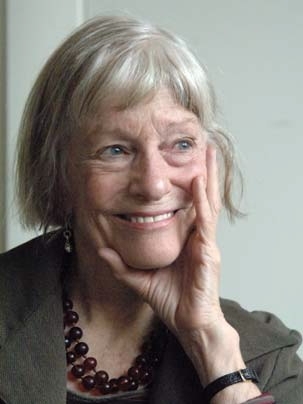Architecture professor Joan Jonas, pioneering performance and video artist, picked up a portapak camera in the 1970s and hasn't looked back. A sculptor by training, over the past three decades she has forged a unique artistic genre, mixing humans, animals, ancient stories and high-tech imagery into widely acclaimed multimedia productions.
"The camera became my pencil," she says. "My performances are rituals, and I use technology, everything from a mirror to computers, to develop them."
Jonas will give an Artist Talk at 7 p.m. on Tuesday, Dec. 4, in Bartos Theater.
Jonas has won numerous awards and her video work has been collected by prestigious museums including the Museum of Modern Art, the Whitney Museum and the Centre Pompidou in Paris. The Museum of Contemporary Art in Barcelona features an exhibition of her work through January.
Jonas is modest about this global reach and about the deep complexity of her work. In a recent interview in her office at MIT, she delighted most in discussing the design-and-build, hands-on part of her work--the way she makes hats.
Jonas designs and constructs elaborate, abstract hats for her performances, following an intuitive process that results in headdresses that function as hair-coverings and as disguises.
"I use Japanese rice paper--it crunches and makes a good sound. To make the hats, I twist it and mash it into layers. I get the right shape. Sometimes I attach the paper to a straw-hat frame, so I can add rope or wire, so it can stand up," she says, her hands forming a hat in the air as she speaks.
Some look like wacky chef's hats; others, like shaman's gear. Rituals like the Tibetan Black Hat Ceremony and the Hopi Snake Dance inspired her to build headdresses for her performances, she says.
"A hat transforms you. It's like a mask, but more subtle. I often use masks--my alter ego, Organic Honey, wore a mask--to alter my persona. Now, I also wear hats to cover my hair, so I am not myself in performances," she says.
"Organic Honey's Visual Telepathy" (1972), featuring a plastic mask and a feathered headdress, is one of 10 works, which include more complex installations and single channel videos, in the Barcelona exhibition.
Others include "Songdelay" (1973), filmed in a vacant lot; "Volcano Saga" (1989), with actress Tilda Swinton as a 12th-century Icelandic woman seeking interpretation of four dreams; and "The Shape, the Scent, the Feel of Things" (2004-2007), a representation of the nonlinear thoughts of art historian Aby Warburg, then confined to a sanitarium.
A Hopi snake dance inspired the head-nurse hat that appears in "The Shape, the Feel, the Scent of Things," she says.
A Pippi-Longstocking-meets-Medusa affair, it is a layered tower of pale rice paper with braids of rope sticking out at odd upward angles. Amazingly, the snake hat, along with its ragged-layered robe costume, seamlessly suits the video work's mental hospital setting.
So do other elements that Jonas often uses in "Shape," though none would seem logically to suit the scene at all. These include a stuffed coyote on a low cart (she has cast each of her dogs, Sappho and Zina, in various works); a metal hoop that recurs throughout her work; images of nature, such as moths; and acts of drawing or painting white circles or snakes or animal heads on the ground.
These simple, vigorous drawings, inspired by Maya Deren's films of Haitian voodoo rituals, suggest a ceremony is underway, Jonas acknowledges.
And it is reasonable to see these mysterious acts and objects as symbols. But the artist has something more free-form in mind, she says.
"I never use the word 'symbol.' I use 'motifs' so the audience has the freedom to read into the images. I use and reuse props, things I find around me, like the hoop or blocks of wood or a freighter passing by that gets caught by a camera. They don't refer to any fixed thing outside the piece," she says.
Her recent and current works include these motifs, and she uses them plus new editing technology to keep probing the genre she practically invented.
Since the late 1970s, her work has delved into literature, ranging from ancient Icelandic sagas to Irish tales to an upcoming work exploring and representing Dante's "Inferno."
"It's a majestic work, very concentrated, and very interesting to do in the present time," she says.
The Dante piece will take more than six months to produce. Jonas is already gathering images, circling back through earlier projects, like a knitter looking for a lost stitch.
"I've got an image from the 1970s of steam rising from the street in New York. It's very inferno-like," she says.
As for the costumes and hats--of course there will be costumes and hats! Maybe a robe like the black rice paper winged one Ragani Hass wore in "Shape"? Or a mask-hat with wolf ears, like the one in "Shape"?
Jonas laughs. "Art is spiritual because it gives people pleasure. Hats, costumes, images, space--they're all part of an ongoing experiment."
Her work is featured in Video Trajectories: Selections from the Pamela and Richard Kramlich Collection and the New Art Trust - on view at the List Visual Arts Center through December 30.
A version of this article appeared in MIT Tech Talk on December 5, 2007 (download PDF).






